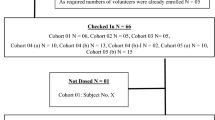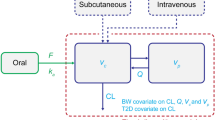Abstract
Objective: The present study was designed to assess the disposition of 14C-repaglinide in whole blood, plasma, urine and faeces, and to measure the total recovery of drug-related material in urine and faeces after a single 2-mg oral dose of 14C-repaglinide during multiple dosing.
Methods: In this single-centre, open-label, phase-I trial, six healthy male volunteers received 2 mg of the prandial glucose regulator, repaglinide, four times daily for 13 days, 15 min before meals. On the morning of day 7, breakfast was omitted and the dose was given as an oral solution containing 2 mg of 14C-repaglinide.
Results: After oral dosing, a mean peak plasma concentration of repaglinide of 27.74 ng · ml−1 (range: 16.84–36.65 ng · ml−1) was observed with a time to peak concentration of 0.5 h. Approximately 20% of repaglinide and its associated metabolites were distributed into red blood cells. No measurable 14C-radioactivity was present in whole blood samples 6 h after dosing. Within 96 h of dosing with 14C-repaglinide, 90% of the administered dose appeared in the faeces and 8% was excreted in urine. In the plasma, the major compound was repaglinide (61%). In the urine, the major metabolites were unidentified polar compounds, the aromatic amine (M1) (24%), and the dicarboxylic acid (M2) (22%). In the faeces, the major metabolite was M2 (66% of administered dose). Therefore, repaglinide was excreted predominantly as metabolites and the major in vivo metabolite of repaglinide in humans was M2. During regular dosing for 6 days, the morning plasma trough levels of repaglinide were, with very few exceptions, almost always too low to measure, indicating the absence of accumulation at this dose of 2 mg four times daily. Repaglinide was well tolerated, and there were no episodes of hypoglycaemia.
Conclusion: After oral dosing with repaglinide, the mean peak plasma concentration was rapidly attained and, thereafter, plasma concentrations decreased promptly. The major route of excretion was via the faeces. These properties make repaglinide a suitable insulin secretagogue for all patients with type-2 diabetes who retain sufficient β-cell function.
Similar content being viewed by others
Author information
Authors and Affiliations
Additional information
Received: 13 January 1999 / Accepted in revised form: 15 June 1999
Rights and permissions
About this article
Cite this article
van Heiningen, P., Hatorp, V., Kramer Nielsen, K. et al. Absorption, metabolism and excretion of a single oral dose of 14C-repaglinide during repaglinide multiple dosing. E J Clin Pharmacol 55, 521–525 (1999). https://doi.org/10.1007/s002280050667
Issue Date:
DOI: https://doi.org/10.1007/s002280050667




